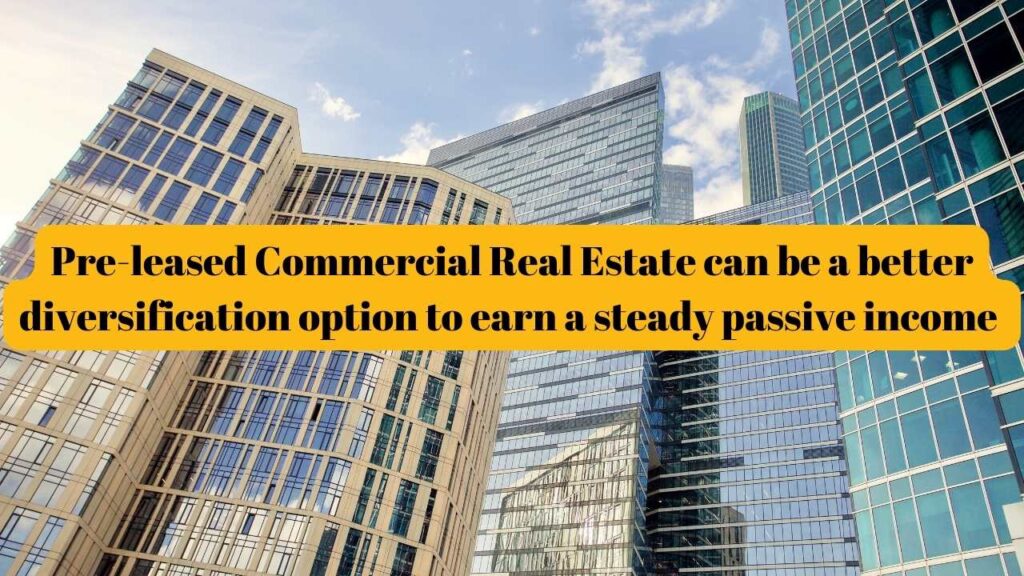Owning a piece of the commercial real estate pie – Why CRE is now more accessible than ever
Usually defined as CRE, Commercial Real Estate refers to the generation of income through extensive use of property for business-related purposes (rather than residential purposes). These properties generate profit through capital gain or rental income in return. Wider in terms, this can extend to even properties leased for businesses, medical purposes, or warehousing.
Commercial Real Estate in the past was not easily approachable as compared to the current scenario. Let us read in this article about the journey and growth of Commercial Real Estate.
Why Savvy Investors Seek to Own Commercial Real Estate?
Commercial real estate largely seeks to provide great passive income options due to which smart investors tend to turn towards it. It compels them to invest in the same for higher profitability:
- Market Size and Returns: The commercial property market in India is closely valued at Rs. 4 trillion, approximately making it huge in number for yielding higher returns if compared to residential properties. These long-term leases are a good source of stable cash flow. Eventually, the commercial property market tends to appreciate with time generating higher returns.
- Diverse Stakeholders: The commercial property market is owned by a varied range of stakeholders. These participants can be individuals, stakeholders, industrial giants, property managers, brokers, and tenants. This, in turn, can add to the investors’ valuation.
- Leasing Terms: Commercial properties often have longer lease terms which can go for several years. This, in turn, ensures less number of tenants for a longer span of time which also enables the maximization of returns.
- High Return Income: As stated above, commercial properties are leased by tenants for a long duration which encompasses the potential for a stable and consistent rental income. These properties are leased to businessmen, which can be a good source of reliable and high income over a longer period of time.
- Risk-Adjusted Investment: For an investor, adding a commercial property to their asset can reduce the risk as it allows them to diversify their portfolio. The portfolio diversifies the risk as the dependence on a single asset is reduced. Hence the risk can be reduced and adjusted accordingly.
- Relationship Building: Operating in a Commercial Real Estate market not only opens the door for several market opportunities but also lets the investor build a valuable relationship with the contractors, property managers, tenants, industrial personnel, and many more, which can be beneficial in expanding this business in the long run.
- Taxation Benefits: Investors can easily approach several tax benefits by investing in commercial properties. They can reduce expenses such as property taxes, mortgages, insurance premiums, and depreciation.
Factors Making Commercial Real Estate Accessible
Commercial Real Estate has been largely influenced over time. These involve certain factors, such as:
Fractional Ownership Real Estate
Fractional Ownership refers to the state when the investor owns a part of the commercial property. In other words, many investors pool a certain fund for the ownership of a single property. This investment model is rapidly growing across the country with its diversification benefits and higher returns. This is the sole reason to attract savvy investors to invest in this smart investment option.
Due to the scarcity of financing options for small investors and the high cost of commercial real estate business, the model is paving its way through the country at large.
The fractional ownership in real estate occurs in various kinds:
- Joint Development Agreements (JDAs)- A Joint development agreement is a contractual relationship between the landowner and the developer where both of them join efforts in land development through property sales.
- Real Estate Investment Trusts: Another popular method for fractional ownership is a Real Estate Investment Trust. These are publicly listed businesses that are totally involved in owning and managing a portfolio of real estate assets which in turn generate income. Investors can acquire the REIT shares and receive dividends based on the properties owned by the REITs.
- Fractional Ownership Platforms: Also known as crowdfunding platforms popularly, Fractional ownership platforms are not SEBI regulated as compared to the trusts. This allows the investors to choose any size of investment they want in return, to which each of them owns a particular share of a property and receives rental income.
- Co-working Spaces: The trend of co-living and co-working spaces has gained popularity in major cities of India like Delhi, Bangalore, Mumbai, and Pune. The share is owned by single entities, the investors can own fractional shares.
Small and Medium Real Estate Investment Trusts (SM REITs)
The introduction of Small and Medium Real Estate Investment Trusts from SEBI has made commercial real estate even more accessible. SM REITs have opened doors of real estate investments for even the middle class and have burst the myth that real estate investments are only for the rich to make.
This is because the regulations of SM REITs allow investors to start investing in commercial properties with a cheque amount as low as Rs 10 lakh only. Hence, this will make commercial real estate even more widely accessible for middle-class investors.
Additionally, SM REITs also allow investors to trade through NSE and BSE with their units being held in their demat accounts. Here are some key features of SM REITs due to which it has made commercial real estate investments easy and available for wider investors:
- Easy Assessment of Risks
- Assessment of Return Potentials
- Helping to Plan Retirement Goals
Overall, the introduction of SM REITs has opened doors of investment opportunities for investors seeking a chance to get into the real estate industry, more specifically, in owning commercial real estate.
Conclusion
To conclude, investing in commercial real estate might not be more convenient. With the introduction of concepts such as FRE and SM REITs by SEBI, investors have gained an upper hand in entering the real estate market. Partner with BHIVE now to join the pool and enjoy the benefits of commercial real estate properties.
FAQs
- What are the three types of REITs?
The three types of REITs include equity REITs, Mortgage REITs, and Hybrid REITs.
- Why is investing in commercial real estate better than residential?
Commercial real estate is always a better investing option as compared to residential ones. Despite the fact that commercial real estate is a bit costly as compared to residential real estate, it yields more profits and higher rental returns. Moreover, the value of commercial real estate constantly increases to make it an even better investment than residential.
- Why do investors invest in commercial real estate?
Investors seek to make the most profit out of their investments. With commercial real estate, investors tend to make higher returns along with beating inflation. This is because, with a growth in the economy, the rent of the commercial real estate also increases and hence maintains the profit rate against inflation. This makes it a prime choice for investors to invest their money.






No comment yet, add your voice below!